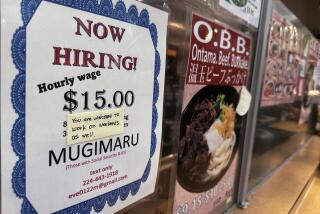America’s jobless claims soar above 600,000
WASHINGTON — The number of American workers filing new jobless benefit claims unexpectedly jumped above 600,000 last week to a fresh 26-year high, signaling that the nation’s recession is widening and deepening.
Separately, U.S. productivity growth -- a measure of how much workers produce per hour of labor -- more than doubled between the July-through-September quarter and the final three months of the year. But instead of seeing the data as evidence of improvement, analysts said the jump from an annual average of 1.5% to 3.2% was yet another sign of trouble.
In essence, companies reacted to the economy’s sharp contraction by cutting workers at a faster pace than output, making it appear that those who remained on the job were growing more efficient.
The latest economic soundings bode ill for today’s January jobs report, which many forecasters now say could show a monthly loss of 500,000 or more positions.
Since September, the economy has shed nearly 2 million jobs, according to government statistics, and most forecasters predict that the losses will keep growing in the coming months.
Continuing jobless claims -- those lasting more than a single week -- hit a record-high 4.79 million, the latest Labor Department report showed, indicating that those who lose jobs are having an increasingly difficult time replacing them. The government has been keeping claims data since 1967.
Initial claims climbed 35,000 to a seasonally adjusted 626,000 during the week that ended Jan. 31, substantially more than the 2,000 or so that many economists had predicted and a level unseen since October 1982.
The government’s latest productivity report, which includes labor-cost statistics, showed that workers are seeing almost no increase in earnings, which may be good news for controlling inflation but bad news for living standards.
Unit labor costs edged up at only a 1.8% annual rate, which demonstrates that the recession and weakening labor market are leaving workers with little bargaining power.
Output by non-farm businesses dropped at a 5.5% rate during the fourth quarter, the most since 1982. However, hours worked plunged at an even steeper 8.4% pace, the biggest drop since 1975.
--
More to Read
Inside the business of entertainment
The Wide Shot brings you news, analysis and insights on everything from streaming wars to production — and what it all means for the future.
You may occasionally receive promotional content from the Los Angeles Times.










